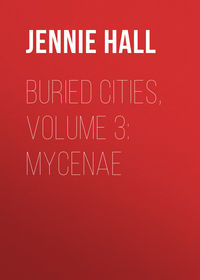Kitap dosya olarak indirilemez ancak uygulamamız üzerinden veya online olarak web sitemizden okunabilir.
Kitabı oku: «Buried Cities, Volume 3: Mycenae», sayfa 5
PICTURES OF MYCENAE
THE CIRCLE OF ROYAL TOMBS
Digging within this circle, Dr. Schliemann found the famous treasure of golden gifts to the dead, which he gave to Greece. In the Museum at Athens you can see these wonderful things. (From a photograph in the Metropolitan Museum.)

DR. AND MRS. SCHLIEMANN AT WORK
This picture is taken from Dr. Schliemann's own book on his work.

THE GATE OF LIONS
The stone over the gateway is immensely strong. But the wall builders were afraid to pile too great a weight upon it. So they left a triangular space above it. You can see how they cut the big stones with slanting ends to do this. This triangle they filled with a thinner stone carved with two lions. The lions' heads are gone. They were made separately, perhaps of bronze, and stood away from the stone looking out at people approaching the gate.

INSIDE THE TREASURY OF ATREUS
No wonder the untaught modern Greeks thought that this was a giants' oven, where the giants baked their bread. But learned men have shown that it was connected with a tomb, and that in this room the men of Mycenae worshipped their dead. It was very wonderfully made and beautifully ornamented. The big stone over the doorway was nearly thirty feet long, and weighs a hundred and twenty tons. Men came to this beehive tomb in the old days of Mycenae, down a long passage with a high stone wall on either side. The doorway was decorated with many-colored marbles and beautiful bronze plates. The inside was ornamented, too, and there was an altar in there.

THE INTERIOR OF THE PALACE
From these ruins and relics, we know much about the art of the Mycenaeans, something about their government, their trade, their religion, their home life, their amusements, and their ways of fighting, though they lived three thousand years ago. If a great modern city should be buried, and men should dig it up three thousand years later, what do you think they will say about us?

GOLD MASK
This mask was still on the face of the dead king. The artist tried to make the mask look just as the great king himself had looked, but this was very hard to do.

A COW'S HEAD OF SILVER
The king's people put into his grave this silver mask of an ox head with golden horns. It was a symbol of the cattle sacrificed for the dead. There is a gold rosette between the eyes. The mouth, muzzle, eyes and ears are gilded. In Homer's Iliad, which is the story of the Trojan war, Diomede says, "To thee will I sacrifice a yearling heifer, broad at brow, unbroken, that never yet hath man led beneath the yoke. Her will I sacrifice to thee, and gild her horns with gold."

THE WARRIOR VASE
This vase was made of clay and baked. Then the artist painted figures on it with colored earth. This was so long ago that men had not learned to draw very well, but we like the vase because the potter made it such a beautiful shape, and because we learn from it how the warriors of early Mycenae dressed. Under their armor they wore short chitons with fringe at the bottom, and long sleeves, and they carried strangely shaped shields and short spears or long lances. Do you think those are knapsacks tied to the lances?


BRONZE HELMETS
These may have been worn by King Agamemnon, or by the Trojan warriors. They are now in the Metropolitan Museum in New York.

